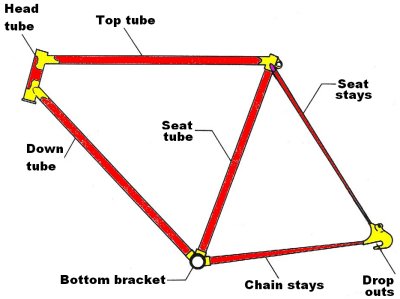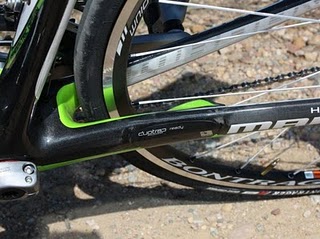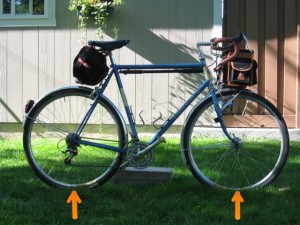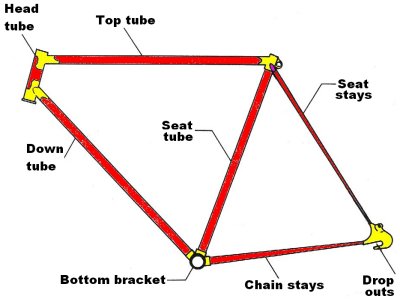In part 1 of this series I hinted at some of the differences between a touring bicycle and a bicycle for racing or performance. Now I will get more specific about what to look for in a touring bicycle.
Let’s use our bicycle frame picture for a reference again.
A touring bicycle will have relatively long chain stays…… for a couple of reasons. First, if the bicycle will be loaded with panniers or saddlebags on either side of a rear rack ,longer chain stays will allow the bags to be placed farther aft, reducing the chance that the riders feet will hit the bags when pedaling.
Longer chain stays will move the rear wheel farther back too. This will allow for more clearance between the tire and the frame. (Good for fat tires and fenders!)
Don’t worry too much about a number for the chainstay length. Just look at the bike with wheels and tires mounted and visually determine if there is room between the tires and the frame for fenders. If you just have a frame with no wheels/tires then measure the chainstay length from the center of the bottom bracket to center of the rear dropout. 17 3/4 to 18 inches ( 45 to 46 centimeters) is what you are looking for. No Bueno
No Bueno Mui bien
Mui bien
Look at the fork too. Make sure there is enough clearance for fenders.
A touring bicycle will be ridden steadily for hours at a time. There will be no sprinting or hard echelons. On a comfortable touring bike the top of the handlebars will be within a couple of centimeters, or level with, the top of the saddle. Forget all the mumbo jumbo the bike fitters, who will charge upwards of $200.00 to adjust your saddle and handlebars, spout about performance and “your game”. Your game is all day comfort. To achieve this, many of the best touring bike makers will slope the top tube up a few degrees from the junction with the seat tube. Then they will extend the top of the head tube a few centimeters. Voila, the handlebars are up where they belong for comfort, without resorting to some crazy looking extensions.
Of course, in order to carry things on the bike, you will need some sort of rack system. A good touring bike will have tabs brazed onto the frame near the rear dropouts and on the fork dropouts. These tabs have threaded holes for rack and fender attachment. Look for two “braze ons” on the rear dropout (for fenders as well as racks) and one or two on the fork. Look for bolt holes in the mid section of the front fork as well. These are useful for attaching front or “low rider” racks.
Most bike frames have bolts in the down and seat tubes for water bottle cages. Some will have a place for another cage on the bottom of the down tube near the bottom bracket. On a self supported tour, the more ways to carry water the better.
These are just some of the things to consider in a touring bicycle. In future articles we will get into the details about goodies like racks, fenders, tires, etc.


